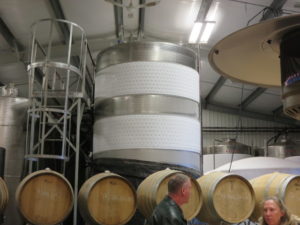One of the things I especially enjoy about driving around wine country is seeing the lush, stra ight rows of vines tethered to the delicate-looking trellises. I love seeing vineyards because they remind me that the delicious nectar that I so enjoy has its start on a farm.
ight rows of vines tethered to the delicate-looking trellises. I love seeing vineyards because they remind me that the delicious nectar that I so enjoy has its start on a farm.
And, when I visit a winery, I love seeing all the gleaming stainless-steel tanks and rooms full of beautiful, hand crafted barrels. At the same time, thinking about the huge investment required for all the specialized winemaking equipment makes me catch my breath.
The  winery owners I’ve met come from all different backgrounds. For some, it’s their fir st or only business. For others, it’s a second career, or even a retirement project. And yet, despite the differences, they do have some things in common. The most obvious commonality is their passion for wine. But beyond that, they also are all risk takers and careful business persons (well, at least those who manage to make a go of it).
winery owners I’ve met come from all different backgrounds. For some, it’s their fir st or only business. For others, it’s a second career, or even a retirement project. And yet, despite the differences, they do have some things in common. The most obvious commonality is their passion for wine. But beyond that, they also are all risk takers and careful business persons (well, at least those who manage to make a go of it).
Though I’ve always assumed the business of owning a winery was risky, a recent writing assignment I got from the Chartered Insurance Professionals (CIP) Society gave me a whole new appreciation of the types of risks involved. The CIP Society asked me to write a paper on insurance issues faced by wineries. It was a fun and interesting assignment that gave me an excuse to “talk business” with people involved in the Canadian wine industry.
The primary audience for the paper was insurance professionals, so the paper is admittedly a bit technical. But, for those of you who – like me – are inherently interested in the business of owning a winery – you might find the paper interesting.
The CIP Society has graciously given me permission to share the paper – called “From Rootstock to Bottle” – with my readers. You can find it by clicking here.